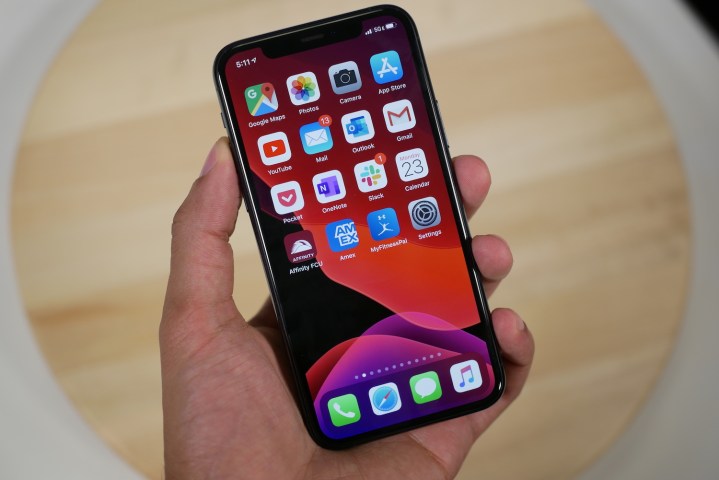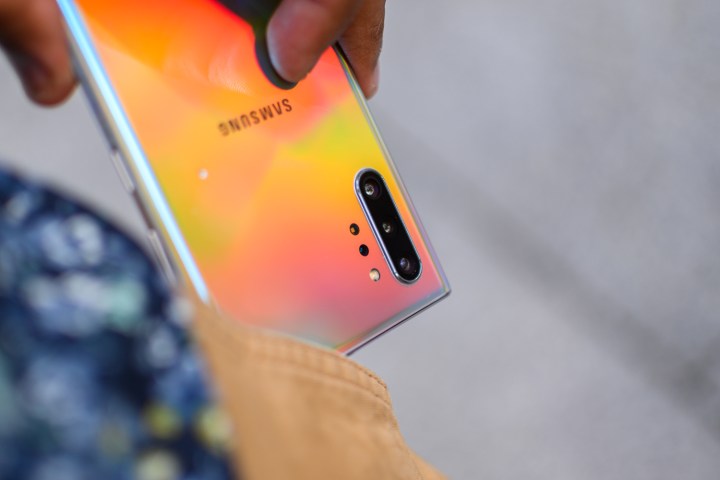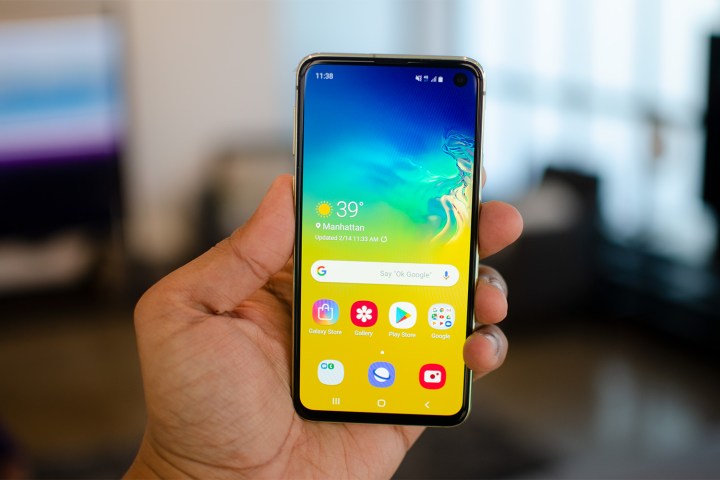There are many factors to consider, from design and operating system to security and durability. We fully test every phone we can get our hands on here at Digital Trends, and after conducting hundreds of reviews, we’re confident in recommending whether a particular phone is a good buy for you, or if you’re better off with something else.
After much debate and soul searching, we landed on the Apple iPhone 11 Pro as our top pick for the best phone available right now, though, for Android fans, Samsung’s Galaxy Note 10 Plus is still a close second. Here’s why the
Apple iPhone 11 Pro
Best smartphone overall

Why you should buy this: You get a beautiful screen, a versatile camera, and all-day battery life in a premium package.
Who it’s for: Anyone who wants the best all-around phone available.
Why we picked the
Apple has built on the elegant design of its flagship range with a raft of refinements, making the
The
Apple’s A13 Bionic chip is lightning fast. It offers a 20% bump on the iPhone flagship’s earlier processor and beats out every other phone we’ve tested so far in terms of raw power. The
Most manufacturers have stepped up their photography game in recent years and Apple was falling behind, but it has reclaimed top spot with the 11 Pro. The main camera features three lenses, arranged in a controversial square module at the top left on the back. There’s a standard 12-megapixel wide-angle lens with an f/1.8 aperture, a 12-megapixel telephoto lens with an f/2.0 aperture, and a 12-megapixel ultra-wide-angle lens with an f/2.4 aperture. This camera is equipped for every situation, whether you’re snapping friends in a nightclub, capturing a beautiful landscape, or zooming in on some action from afar. Apple’s portrait mode is wonderful, you can fit more in with the 120-degree field of view that the new ultra-wide-angle lens offers, and there’s a night mode that performs amazingly well in low light conditions. On the front, the 11 Pro sports a 12-megapixel lens for selfies.
Battery life is another strength, with the
If the the
Samsung Galaxy Note 10 Plus
Best Android smartphone

Why you should buy this: You want the most powerful, feature-packed
Who it’s for: Anyone who wants the best
Why we picked the Samsung
The Samsung
Inside there’s plenty of power to run the most demanding apps and games thanks to a Snapdragon 855 processor that’s paired with a staggering 12GB of RAM to make this a multitasking monster. As befits a phone built for productivity, there’s 256GB of storage and room for expansion via MicroSD card. The Samsung
You’ll find an impressive triple-lens camera in the Note 10 Plus, which combines a 12-megapixel main lens with a variable f/1.5 to f/2.4 aperture and optical image stabilization, a 12-megapixel f/2.1 telephoto lens (with OIS), and a 16-megapixel ultra-wide-angle lens with an f/2.2 aperture; there’s even a time-of-flight sensor for better depth sensing. It’s a versatile setup that performs very well in most situations.
The S Pen is the secret weapon in Samsung’s Note line and it’s more useful than ever, with remote control functions thanks to the Bluetooth connectivity. You can also have the
Battery life to write home about rounds out a truly desirable
You could argue some of the features here are gimmicky and unlikely to be used often, but Samsung’s kitchen-sink approach doesn’t prevent it from turning out phones that do all the basics well and the
Google Pixel 3a
Best budget smartphone

Why you should buy this: You’re on a budget, but you still want a powerful phone.
Who it’s for: Bargain buyers who want a stock
Why we picked the
The Pixel 3a is a fantastically solid
The Qualcomm Snapdragon 670 processor is backed by 4GB of
While midrange and budget smartphones have been growing more and more attractive and powerful, certain elements always tend to be lacking, and the camera is the main one. Google’s Pixel 3a changes all that by making our favorite
The Pixel 3a comes complete with clever software features like Now Playing, which displays songs playing in your vicinity on the lock screen, and Call Screen, which enables Google Assistant to screen your incoming calls.
You get a decent 64GB of storage inside. There’s no space for a MicroSD card, but you do get a 3.5mm audio jack and a USB-C port for fast wired charging. To round out an excellent phone, there’s a 3,000mAh battery that will easily see you through an average day with change.
If we had to dig out a flaw, the lack of wireless charging is a little disappointing and there’s no IP rating, though Google says the Pixel 3a is splash- and dust-resistant. If you’re sold, but you prefer a bigger screen, then the Pixel 3a XL gives you a bigger, 6-inch screen..
Samsung Galaxy S10e
Best small smartphone

Why you should buy this: It’s the perfect size for easy, one-handed operation.
Who it’s for: Anyone seeking a smaller phone that still boasts great design and performance.
Why we picked the Samsung Galaxy S10e:
Samsung has taken some of the best elements of the S10 and packed them into an even more compact and affordable body in the shape of the
Inside, you get the same lightning fast Snapdragon 855 processor, which makes this phone capable of running all the latest games and apps. It comes with 6GB of
Samsung has gone with a dual-lens main camera in the S10e, pairing a standard 12-megapixel lens with a variable f/1.5 to f/2.4 aperture and a 16-megapixel ultra-wide-angle lens with an f/2.2 aperture. You’ll find a wide array of options and modes in the camera app, which also allows you to shoot 4K video in
The 3,100mAh battery will get you through an average day, but it may need a top-up if you’re planning to be out at night. Sadly wired charging isn’t very fast, but you can wirelessly charge at the same speed. Ultimately, you get most of what makes Samsung’s Galaxy flagships special affordably with the S10e.
Research and buying tips
What is an unlocked smartphone?
A locked
Can smartphones get viruses?
While it is possible to get viruses on iPhones or
What should I do with my old smartphone?
The most obvious thing to do with your old
How long should a smartphone last?
Realistically, you should expect to get two to three years out of your
Do phones cause cancer?
The question of whether cell phone radiation is dangerous is still hotly contested in some quarters. It is technically classified as “possibly carcinogenic to humans” but that puts it in the same category as coffee, gasoline, and nickel. There have been many studies, but we still lack any scientific evidence to provide a definite answer to the question one way or the other. Most official bodies, including the Federal Communications Commission, Center for Disease Control, and National Cancer Institute agree there’s no proven link right now, but also acknowledge that we need more research.
How do prepaid phones work?
Prepaid cell phones work just like any other phone, but they come without a monthly contract or long-term commitment. You usually pay for service in advance. When you buy a prepaid phone they tend to come with a fixed number of minutes, text messages, and possibly a fixed amount of mobile data. This removes the chance of any overage charges. When you run out, you simply top up by buying more minutes, texts, and data in blocks.
Which OS is best for you?
This is where things get personal. Picking a
Apple’s iOS is a beautiful, simple operating system and the App Store offers the best app selection imaginable. Each and every aspect of iOS is curated by Apple, and it shows.
Since Apple is the only company that makes iPhones, it also has complete control over software updates. As such, iPhone users always get the most recent and best iOS experience possible.
How we test
A phone is so much more than its spec sheet. Your entire life is stored on it, from your photos and contacts to your music and your favorite apps. For that reason, we take great care when we review phones to recommend only the absolute best out there.
We use each phone we review as our daily driver for an extended period to test out all the features. We do benchmarks, play games, take photos, plunge them in water, and use them until their batteries expire. Then we charge ’em up and do it all over again. We test devices like real people use devices. We’re not in some stuffy lab during obscure tests. We’re running around the cities we live in using these phones just like you use your phones. Then we think about each phone in comparison with its competitors to come to a decision: Should you buy this phone or something else? If the answer is “something else,” we tell you what to buy instead.